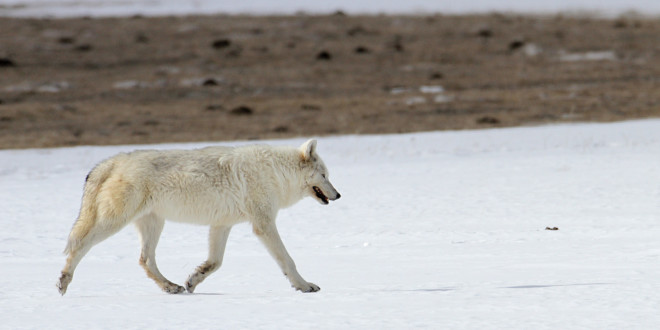A new study funded by the National Park Service has posited a link between wolf hunts and wolf sightings in Yellowstone National Park.
The study, which was co-authored by researchers at the University of Washington in Seattle and published today in PLOS ONE, analyzes wolf harvest and sightings in both Yellowstone and Alaska’s Denali National Park and Preserve. In each case, visitors were twice as likely to see a wolf when hunting was prohibited around the Park’s borders.
Among the study’s other co-authors: Stephen Arthur and Nicholas Bromen of the NPS in Denali; and Kira Cassidy, Rick McIntyre and Douglas Smith of the NPS in Yellowstone.
Now, you may look at this finding and think, duh, of course hunting and wolf sightings are linked. More wolves killed equals fewer wolves roaming around, right? However, the link between seeing wolves in national parks and hunting them outside of it isn’t as simple as it seems. From a UW press release:
“This is the first study that demonstrates a potential link between the harvest of wildlife on the borders of a park and the experience that visitors have within the park,” said lead author Bridget Borg, a Denali wildlife biologist who completed this research while earning her doctorate from the Institute of Arctic Biology at the University of Alaska Fairbanks.
The researchers looked at the dynamics between hunting and viewing wolves at these two national parks because they are the only ones where visitors have a good chance of seeing a wolf. Both parks have long-term monitoring programs that have collected years of data on resident wolf populations, including years when wolf harvest was permitted and years when it was prohibited near the borders of both Denali and Yellowstone.
Adjacent to Denali, wolves are primarily trapped during legal harvests, while states adjacent to Yellowstone permit shooting wolves during hunting season. Wolves have always existed in Alaska and are generally regarded as an important part of the state’s ecosystem — by trappers and wildlife enthusiasts alike.
The sentiment is quite different around Yellowstone, where wolves were reintroduced by wildlife biologists in 1995. Cattle ranchers, in particular, must contend with predators that hadn’t previously roamed those areas during their lifetime as ranchers.
Wildlife viewing is an important economic driver for the states surrounding the two national parks. Wolf-watching activities in Yellowstone after the 1995 reintroduction have brought in an estimated $35 million each year to Idaho, Montana and Wyoming. In Alaska, wildlife viewing activities supported more than $2.7 billion in economic activity in 2011.
At the same time, these states are required to provide for consumptive uses of wildlife; in 2011, hunting in Alaska supported more than $1.3 billion in economic activity, and revenue in Montana from buying wolf tags alone brought in over $400,000.
The study analyzed wolf sightings, pack sizes, den locations, and harvest statistics from 1997 to 2013 in Denali; in Yellowstone, researchers analyzed the same type of data from Yellowstone between 2008 and 2013, since gray wolves in the Northern Rockies were only removed from the Endangered Species List in 2008.
Nonetheless, the findings in each national park were consistent; each pointed to a decline in wolf sightings when hunting was permitted at the periphery of park boundaries. Further, the findings could provide key insights into other carnivore activity in both parks. From UW:
“We have shown there is a tradeoff between harvesting and viewing wolves, but these findings could extend to other large carnivores that also move in and out of parks,” said senior author Laura Prugh, a University of Washington assistant professor of quantitative wildlife sciences in the School of Environmental and Forest Sciences.
“In an ideal world, there wouldn’t be a tradeoff. You could have wolf harvests outside of the parks, which also bring in a lot of economic activity, and it wouldn’t have an effect on the populations or probability that tourists are going to see wildlife in the parks.”
The study added that the link between hunting and sightings may have less to do with the population as a whole and more to do with the behavior of individual wolves. For instance, in the parameters of the study, sightings of individual wolves were more frequent than whole pack sightings. The research suggests that when those wolves are picked off by hunters, population isn’t affected as much but the visibility factor goes down. Hunting and trapping also likely prompts behavioral changes in wolves, who learn to stay away from roads. Of course, the study posits, vegetation and topography also play an important part in wolf visibility.
 Yellowstone Insider Your Complete Guide to America's First National Park
Yellowstone Insider Your Complete Guide to America's First National Park





